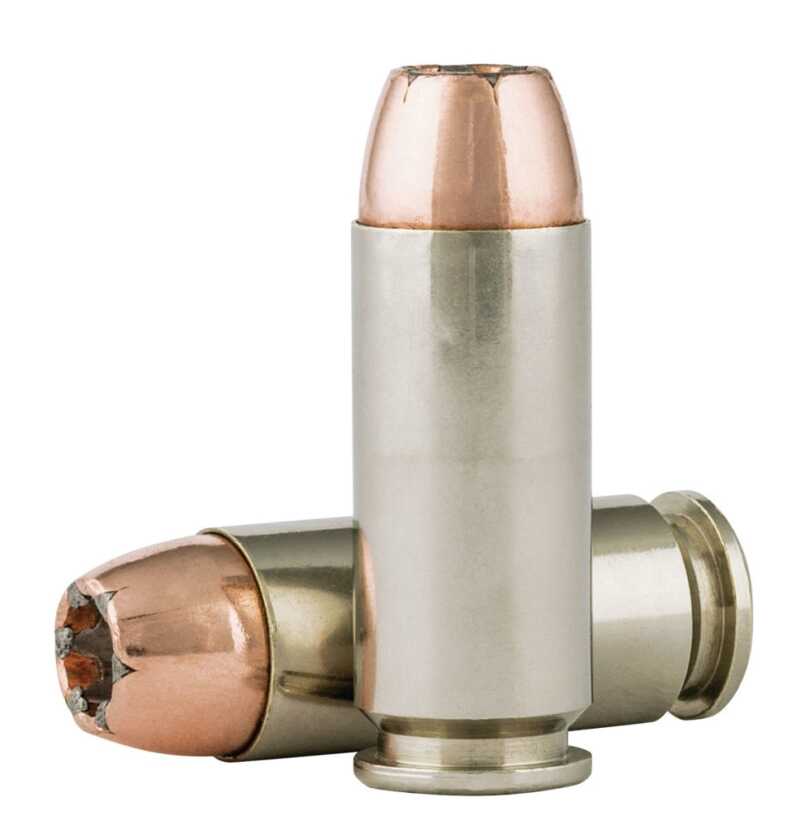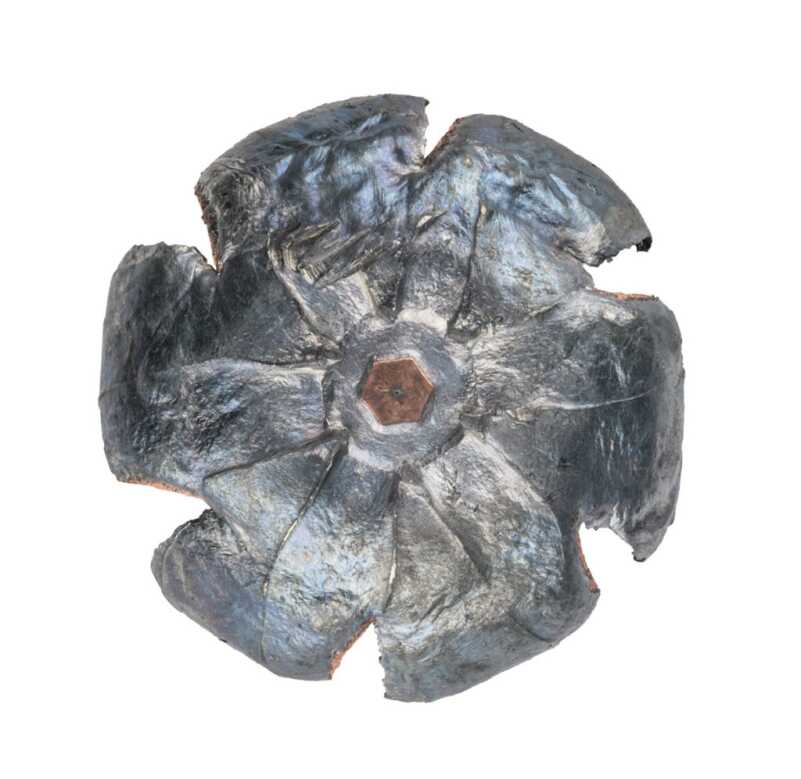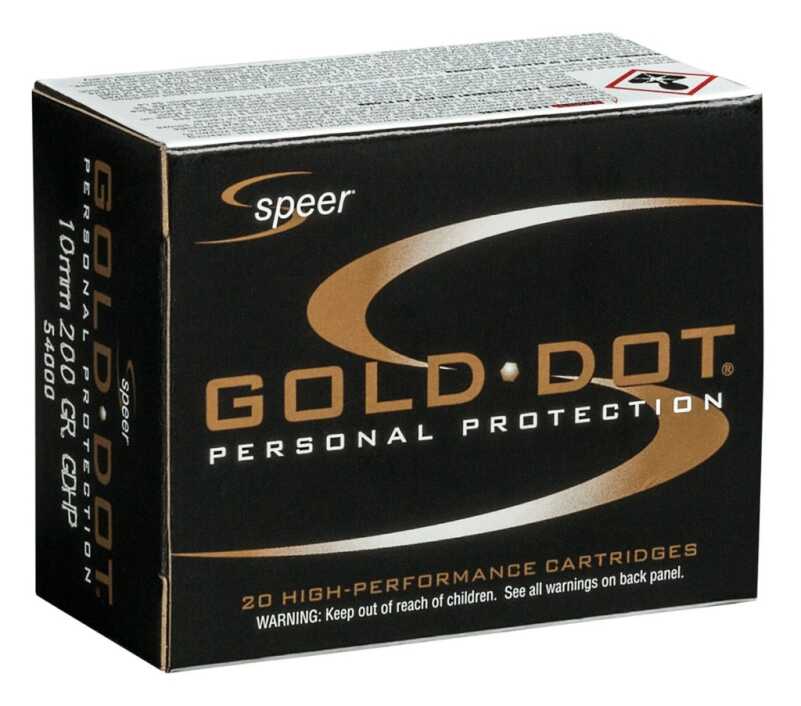I’m a big fan of all things 10MM, and Speer got my attention recently when the ammunition maker announced the new Speer Gold Dot 10MM Auto Personal Defense round, firing a 200-grain Gold Dot bullet.
On the Speer website, the Gold Dot 10MM load is rated at 1,100 feet per second (fps) at the muzzle, fired from a handgun with a five-inch barrel. Muzzle energy is rated at 537 foot-pounds (ft-lbs.) of energy
All of which seemed great. But I wondered how the ammo would perform for me. So, I asked, and Speer sent me four boxes of Gold Dot 10MM Auto for some testing.
Now, I didn’t perform the definite testing. I only received 80 rounds and tried out the ammo in just two pistols. Speer, for example, rates the Gold Dot bullet as, “tough and unbelievably consistent through all common barriers.” Likely true, and probably a major reason Gold Dot ammunition is a top choice for law enforcement. But I didn’t shoot the ammo through any barriers.
I did, however, shoot the ammunition offhand and from a rest at ten yards, and from a rest at 25 yards, for accuracy and general function, and chronographed ten rounds. In this limited testing, the Gold Dot 10MM performed extremely well.
I tried out the Gold Dot with a Remington R1 Hunter, a long-slide 1911 with a six-inch barrel, and a Sig Sauer P220 Hunter sporting a five-inch barrel. I had trouble with the P220’s rear sight and was 15 rounds in when I decided against using the Sig. I like the pistol and have used it successfully in the past; but with only 80 rounds on hand to start, I switched over to the R1 Hunter.
For accuracy, the Gold Dot and the R1 Hunter produced five-shot groups of .835- and .860-inches from a rest at ten yards. At 25 yards from a rest, my tightest five-shot group came in at 2.04-inches; within that group, the first four shots pegged an impressive .848-inches, with two of the shots touching.
For a self-defense round, I consider that accuracy at both distances very, very good.
At six-feet from the muzzle of the R1 Hunter, my PACT Professional-XP Chronograph clocked in ten rounds of the Gold Dot 10MM at an average of 1,038 fps. The fastest load measured 1,043.4 fps, the slowest 1,032.8 fps.
This ammunition also registered the best Standard Deviation I’ve ever found in factory ammo at just 4.3 fps. I asked GunsAmerica contributor, reloader and all-around ammo expert, Phil Massaro, his thoughts on the Speer’s 4.3 SD.
“When you see an SD in the single digits, it’s an excellent indication that the ammo is running consistently,” Massaro told me. “As a reloader, I strive for the best consistency possible, as that usually equates to accuracy, or more correctly stated, precision. Wide variations in muzzle velocity are indicative of varying pressures or at the very least an inconsistency in components.”
I plugged my numbers into two online ballistic calculators, and, at this muzzle velocity and bullet weight, both calculators estimated the muzzle energy at 479 ft-lbs. Or 57 ft-lbs. of energy less than what Speer rates the round.

The author’s chronograph clocked in the Speer Gold Dot 10MM Auto Personal Defense Loads at an average of 1,038 fps, translating to 479 ft-lbs. of energy at the muzzle.
Now, my chrono isn’t the newest and the most expensive. If my results on this load were just 20 fps low–meaning the real average was 1,058 fps at the muzzle—now the load would register 497 ft-lbs. If it was 30 fps low? The foot pounds go up to 507. And at Speer’s stated 1,100 fps, both online calculators estimate 537 ft-lbs. of muzzle energy.
Of course, my chronograph could be dead on. However, depending on the air pressure, temperature and other environmental factors at work when I tested the ammo? My results could be somewhat different from Speer’s.
The real test for a self-defense bullet’s performance is on the aforementioned barriers, hard and soft, inanimate and warm-blooded. I hope to have a chance to test out the load on some game animals and will report back the results.

Shooting through barriers wasn’t done in this particular testing, though Speer says this level of mushrooming and weight retention is standard with its Gold Dot bullets.
From my limited testing? Speer’s new Gold Dot 10MM Auto Personal Defense ammunition is fast, accurate and extremely consistent, and I didn’t have a single problem with it loading, firing or ejecting.
Visit Speer to learn more about their ammo by clicking HERE.



537 lbs. of MUZZLE energy. It passed through 16 inches of jell. If it was a chest or rib shot it would not pass through 16 inches. How ever what is one calling personal defense 10 feet to 30 feet or 10 yards to 30 yards or more. It’s like buying tires, each person has their preference on velocity and bullet weight. I tend too go towards 5 to 6 inch barrel with reduced powder and get velocity with the longer barrel. 150 to 165 grain and it allows lower pressure to reduce recoil and gets me the best of both worlds. I can shoot a 50AE with 300 grain hp at 50 yards with 5 mags total 35 rounds and had 34 head shots and 1 neck. Not at competition speed, but within 45 seconds. Whatever one is comfortable with is always best for them and stick with it. If it is CCW their is so many factors. Happy range time too all and a Merry Christmas and a Happy New Year.
Please test the round through barriers, particularly auto glass.
Several other velocity tests show the round about 100fps less than advertised, which is odd for Speer.
I’m wondering about the dangers of over-penetration with this heavier round myself. Instead of labeling it a self-defense round maybe it would be a really good hunting round for deer or wild boar where over-penetration wouldn’t be an issue.
My house gun is a G20 and my CCW is a G29SF and in both I too like something in the 155gr HP range loaded to max 10mm velocities. My thinking is that fast moving lighter hollow points tend expand more rapidly and shed their kinetic energy quicker – creating greater hydrodynamic shock – without over penetrating. They are a little ‘snappier’ in the recoil department but the Glock’s tend to shoot softer due to the composite frames and being striker fired. I used to carry the 175gr sliver tips but I think the velocity may be a little too low for those, especially in my G29.
And I DO NOT carry my hand loads in my Glocks for self defense and only use factory loads – for legal reason. But I do like Speer and have no doubt they’ve done plenty of R&D on this ammo …
Guys, for us old school persons Remington bought out Para Ordnance and this is where there good shooting 10mm 1911 came from. The Para’s are still out there but getting harder to find.
The Federal load chosen is just barely more powerful than a 40 S&W. To check durability in a 10mm pistol a full power load should have been chosen such as a 200 grain bullet at 1200 fps
I’m sorry. This “article” is nothing more than an 800-word advertisement for Speer.
I am a professional engineer and certified instructor, who enjoys and carries the 10mm and fires close to 1000 rounds of 10mm per year. Sound like a lot? It’s less than 100 rounds per month, but it’s more than an 80-round fun day at the range with NO terminal ballistic testing.
Some Science: Personal defense ammunition is very little more than a means of transferring ENERGY (NOT velocity) to the intended target. If one avails himself of information available on ballistic testing websites (brassfetcher.com is a good place to start), it can be seen that heavier bullets from the 10-Mike-Mike pass right through a 16 inch ballistic gelatin block, departing with appreciable velocity. Without burdening any of us with a bunch of math so early in the morning, it is obvious that, if the bullet is still moving AFTER leaving the target, then it still has calculable energy, and DID NOT impart all of its energy to the target. The point is, if the intended target is a bipedal assailant about 14 inches thick and wearing three (3) layers of clothing, then bullets of 170 grains and heavier, fired in close quarter situations will almost certainly yield too much penetration. Where is the bullet going to go after it leaves the target and what collateral damage will it do when it gets there?
And while 537 ft. lbs. of kinetic energy may seem impressive to the average reader who has less than 350 ft. lbs. available from his Glock 19, it pales in comparison to the 700+ ft. lbs. of KE available from other offerings.
I would hope that, for personal protection 10mm ammunition, informed readers will investigate the higher calculated energies, larger temporary wound cavity, more appropriate penetration realized by bullets in the 155-to-165 grain weight range in the 10mm.
One other comment on over-penetration: It is taught in NRA personal protection courses as well as responsible independent self-protection classes that the shooter is PERSONALLY RESPONSIBLE for the final resting place of EVERY bullet that he (or she) fires. This statement generally brings the importance of hitting the intended target, over penetration and the blatant stupidity of “warning shots” into better focus.
Mr. McCombie, I wish that you had shown yourself to have the heart of a teacher rather than the heart of a salesman in this piece.
“All of which seemed great. But I wondered how the ammo would perform for me. So, I asked, and Speer sent me four boxes of Gold Dot 10MM Auto for some testing.”
Hmm. Sounds like a personal experience piece. Maybe you should adopt a different attitude.
You are misinformed Sir. You referenced Brass Fetcher in your comment- did you read the information on his site?? If so you’d clearly see “energy” imparted is not a significant consideration. Heavy loads do not correlate with over penetration necessarily. While Speer’s 10mm is still very untested, it does not mean they will pass through a target by any means.
I picked these up for my Kimber as soon as they came out. I have been looking for a SD round that was close to the WW Black Talon rounds of the 90s. I had a Delta Elite at that time and of all the ammo I tested when I first bought the gun, the Black Talon was by far the most accurate and controllable in rapid fire. I am a fan of the heavier bullet at around 1,000 fps rather than a light and fast round. I prefer the recoil feel of the 200g JHP to the snappier kick of the lighter rounds. Same goes for a 200g in a .45. It was my go to round when competing in the 80’s in IPSC.